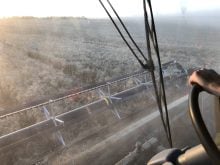A late but rapid snowmelt in Saskatchewan will result in some loss of potential soil moisture, says a Saskatchewan-based hydrology expert at the University of Saskatchewan.
Overall, however, conditions are conducive to good levels of soil moisture infiltration, thanks to a better-than-average snowpack across most of the province and a soil-snowpack interface that is favourable to soil moisture recharge.
“We’ve got a decent snow pack and it’s dry beneath so I expect that we’re going to have very good soil infiltration for the most part,” said research associate and hydrology expert Phillip Harder.
Read Also

U.S. bill could keep out Canadian truckers
The Protecting America’s Roads Act, which was tabled in the U.S. House of Representatives at the beginning of October, would “rid the country of illegal immigrant commercial truck drivers and ineligible foreign nationals.”
“I think we’ll have a base of soil moisture that will sustain a good portion of crop growth (early in the season) but it’s still going to depend a lot in getting that (in-season) rainfall to keep things going.”
In an April 10 interview, Harder said snowpack across Saskatchewan is disappearing quickly.
Based on forecasted daytime temperatures from April 10 to April 14, he said most of the snow will be gone by the end of this week.
Only treelines, shelterbelts and heavily drifted areas are likely to have any snow left by April 15.
“It’s going to go fast,” Harder said. “Right now, I’m expecting that most of this melt will be happening in the next three to four days.”
In addition to a higher-than-normal snow pack across most of the province and extremely dry soil conditions in many areas, the past winter saw little mid-winter melting.
That reduces the amount of snow available for spring infiltration and it creates a layer of ice where the soil and snow meet, making it harder for spring-season meltwater to soak in.
“The fact that we had continuous snow cover throughout the winter for a larger portion of the province than normal means that a lot of (meltwater) will be going in” to the soil, said Harder.
Conditions last fall also favour good infiltration, he added.
“We had kind of this ‘instant winter’ where soils didn’t freeze before we had snow cover accumulation, so we don’t have those very deep frost depths that would restrict infiltration.”
Harder said a slower spring melt would have been ideal in terms of soil moisture recharge. By mid-April, melting typically occurs quickly so all meltwater can’t get into the ground fast enough, no matter how dry the soil is below.
In a recent podcast posted by the Saskatchewan Wheat Commission, Harder encouraged growers to pay more attention to stubble and residue management, techniques that can be used to maximize soil moisture recharge and minimize runoff and evaporation.
By leaving higher stubble in the fall, growers can increase the amount of snow trapped on fields and reduce the amount that’s blown away.
Similarly, growers can reduce runoff and evaporation losses by maintaining healthy levels of crop residue on the surface.
“At the end of the day, you can have huge gains in terms of water equivalent when you have taller stubble heights,” Harder told the commission.
According to research, a one centimetre increase in stubble height would gain, on average, the equivalent of one millimetre of additional moisture in Prairie soils. Similarly, a 10 percent increase in crop residues is generally assumed to result in a five percent decrease in soil moisture evaporation.
“From a hydrology perspective, we always want to think about the water balance,” Harder said.
In other words, keep track of what’s coming in and what’s going out.
“There’s all sorts of new opportunities these days to manage our residues and our stubbles in ways that we never have in the past.”
In a typical year, Saskatchewan crops depend largely on in-season rainfall for grain production. However, stubble and residue management strategies that focus on soil moisture recharge can make a significant difference in productivity.
In 2017, data from Kenaston, Sask., showed that canola crops used 250 mm of total water between planting and harvest. However, only 67 mm of that was supplied by rainfall.
“So in that situation, 75 percent of our crop water use was coming from sources other than rainfall,” Harder said.
Contact brian.cross@producer.com


















